Besides giving its name to a ridiculous riding garment, Jodhpur is stepped in history. Driven from their traditional homeland, the Rathores settled in the region which was on the vital trade route between Delhi and Gujarat, profiting from the trade in opium, sandalwood, dates and copper. They prospered to such an extent that they decided they required a secure headquarters to protect themselves from the covetous desires of surrounding rivals. In 1459 they began to build the city of Jodhpur which could be protected by the steep rocky ridge of a natural defensive position on which they would construct a fort of staggering proportions.
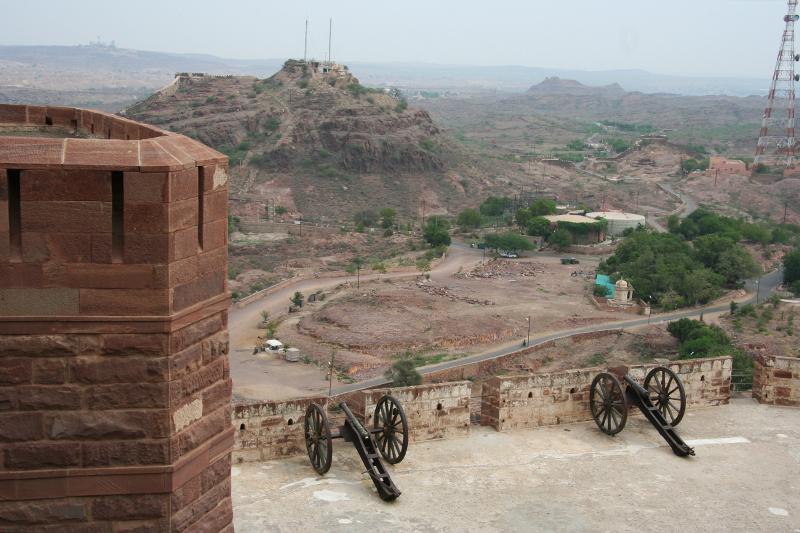 Using the fort as a base, the Rathores soon controlled a large area that, cheerily, was known as Marwar (the Land of Death) because of its harsh topography and hot, dry climate. The 17th and 18th centuries were dominated by a war of independence and internal struggles for succession until the arrival of the British enforced peace during which Sir Pratap Singh (of riding pants fame) ruled with competence and stability.
Using the fort as a base, the Rathores soon controlled a large area that, cheerily, was known as Marwar (the Land of Death) because of its harsh topography and hot, dry climate. The 17th and 18th centuries were dominated by a war of independence and internal struggles for succession until the arrival of the British enforced peace during which Sir Pratap Singh (of riding pants fame) ruled with competence and stability.
Today, thanks to the fort (reputedly Rajasthan’s finest), Jodhpur is very much on the tourist trail but doesn’t have the nuisances and hassles to the same extent as other historic sites. Perhaps we are getting used to the idiosyncrasies of India or perhaps we are coping better, but I am definitely warming to the culture and the people as we travel along.
The old city is cocooned within a 10km length of wall of 16th century origin and walking its narrow, tangled streets, it is easy to imagine how life must have existed for the inhabitants during their heyday of trade and struggles. There is a mass of building block houses, many adorned with Brahmin blue paint which the locals believe help to keep the interior cool and ward off insects. The endless little shops sell everything from western clothing to saris, colourful bracelets and jewelry, spices and teas, toys and temple trinkets and the inevitable tourist tat.
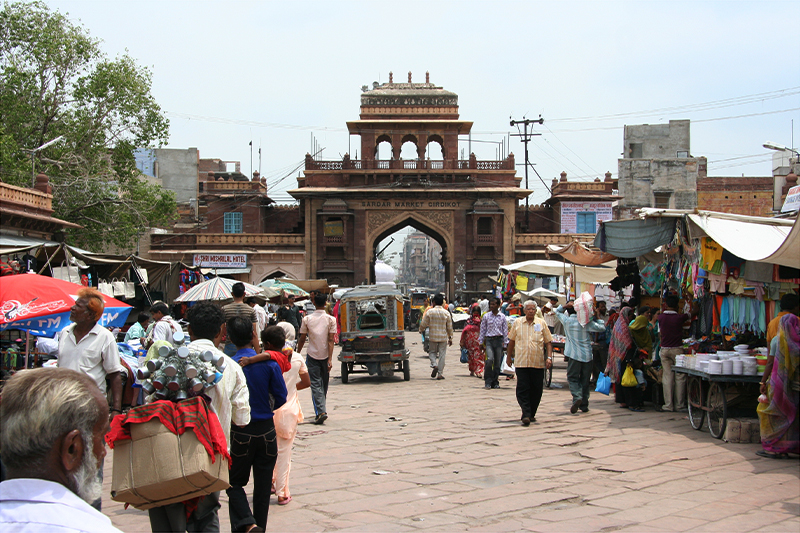 The streets are relatively clean; in the early morning we have spied women clearing away the great weight of yesterday’s litter (though not always with complete success – their brooms must have holes). There is still litter around but not in the great volumes we have encountered elsewhere. Shopkeepers and householders take the trouble to clear the drains in front of their premises and we get the impression that there is some feeling of civic pride to the city that is evident in the air. The place doesn’t smell like a sewer.
The streets are relatively clean; in the early morning we have spied women clearing away the great weight of yesterday’s litter (though not always with complete success – their brooms must have holes). There is still litter around but not in the great volumes we have encountered elsewhere. Shopkeepers and householders take the trouble to clear the drains in front of their premises and we get the impression that there is some feeling of civic pride to the city that is evident in the air. The place doesn’t smell like a sewer.
The heat must bring some imperative to cleanliness and it is certainly hot here. The temperature seems to build through the day to reach into the 40s (degrees centigrade) by late afternoon before it begins to cool a little. We should be drinking gallons of water. However, with the absence of toilets this is not possible. The trick is to drink enough water so as not to become dehydrated but not so much that we need to go for a pee. This doesn’t seem to concern the local males, who relieve themselves wherever they are when the urge strikes. We even came across one fellow with his tackle out, hands on hips, who turned to watch us pass. An Indian flasher.
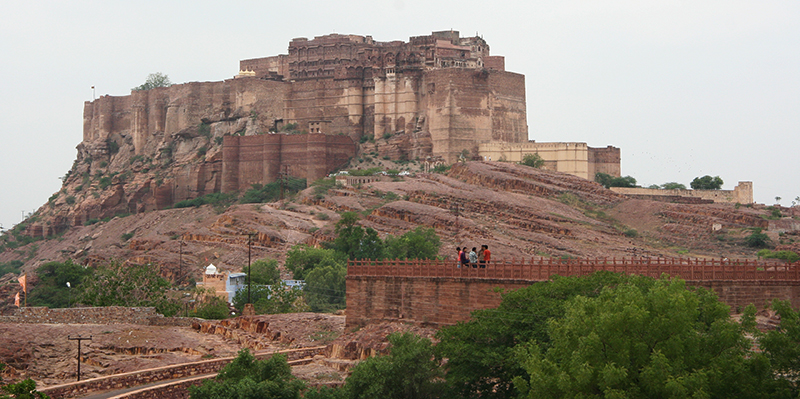 But it is the fort we have all come to see rather than the toilet habits of the male population. Still owned and run by the present day Maharaja, the mighty red fortress of Mehrangarh appears to be chiseled from the rock on which it stands as the structure merges with its base. The approach road winds up the hill totally open to defensive fire. The great gates of the fort, studded with spikes, are set at right angles to the entrance arch so that they cannot be charged by elephant. The thick stone walls still carry the battle scars of cannon ball and shot but these barely seem to have penetrated. It is with little surprise that we learn that no invading army has conquered the battlements.
But it is the fort we have all come to see rather than the toilet habits of the male population. Still owned and run by the present day Maharaja, the mighty red fortress of Mehrangarh appears to be chiseled from the rock on which it stands as the structure merges with its base. The approach road winds up the hill totally open to defensive fire. The great gates of the fort, studded with spikes, are set at right angles to the entrance arch so that they cannot be charged by elephant. The thick stone walls still carry the battle scars of cannon ball and shot but these barely seem to have penetrated. It is with little surprise that we learn that no invading army has conquered the battlements.
Once inside, having presented ourselves at the ticket office with a fistful of notes, we are given a ‘free’ audio guide. What a joy this turns out to be; a superbly articulated and informative history of the fort, complete with interesting information and reminiscences from the royal family.
We continued up the steep hill to the last gate where there are a series of tiny handprints made by the widows of Maharaja Man Singh before they threw themselves on to his funeral pyre in 1843 in the last act of self sacrifice (Sati) of the Jodhpur dynasty. As they burnt to death, they were not allowed to cry out and it must have been the most horrible way to die imaginable. Debbie declined to undertake such self sacrifice should I pass away first. I am disappointed.
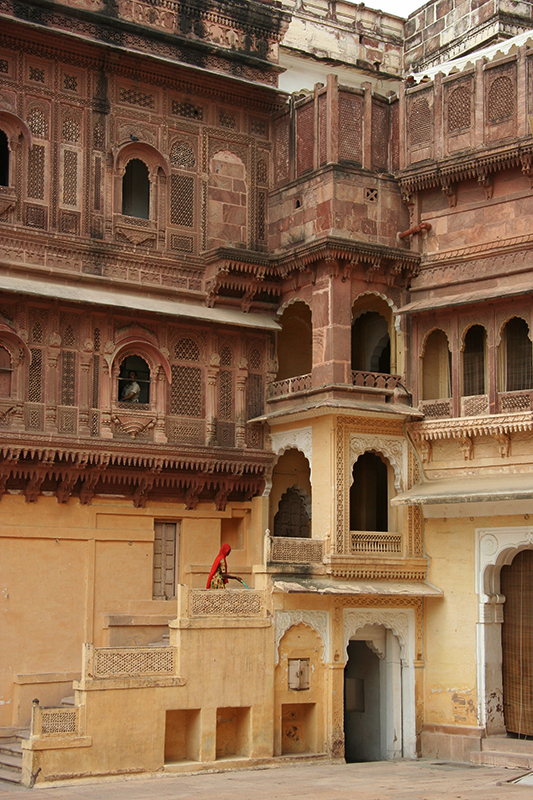 Once inside the palace there are a series of courtyards in which Maharajas are still crowned (Singhar Chowk) and the treasury resided. The enclosing walls are complete with windows that jut into space with fine intricate lattice work behind which women of the court could watch the proceedings without being seen. The carving is so fine and delicate that it looks as if the upper floors have been made out of matchstick but, in fact, it is simply manufactured from a darker stone.
Once inside the palace there are a series of courtyards in which Maharajas are still crowned (Singhar Chowk) and the treasury resided. The enclosing walls are complete with windows that jut into space with fine intricate lattice work behind which women of the court could watch the proceedings without being seen. The carving is so fine and delicate that it looks as if the upper floors have been made out of matchstick but, in fact, it is simply manufactured from a darker stone.
Leading off the courtyards are hundreds of rooms that contain all manner of art and artifacts that stretch back over the period of the palace’s existence. They hold all sorts of interesting things that we have not seen: a collection of ornately decorated elephant howdahs (saddles) essential for glittering processions, a display of cots for the first born male and heir to the title, a range of palanquins (carriages carried by men) and covered palanquins for the women in purdah (seclusion), and a fine display of miniature paintings (an Indian specialty). Even the armoury, complete with the finest implements of combat, was fascinating.
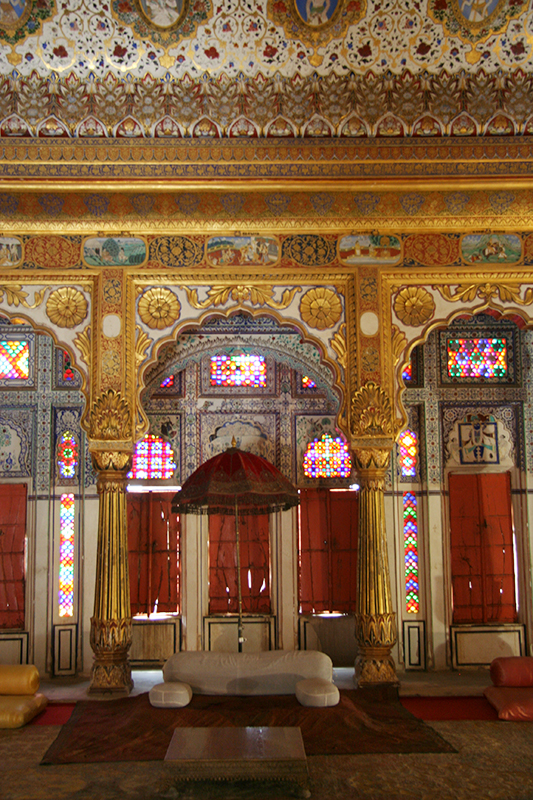 The rooms are lavishly furnished and ostentatiously decorated and have wonderfully evocative names such as Pleasure Palace (Sukh Mahal) and Flower Palace (Phool Mahal), the latter being where traditional dances were performed. There is a large Durbar Hall that was used by the Maharajas as a counsel chamber in which the great nobles of the day would debate issues and decide policy. The fine paintings that adorn the walls were created using a curious concoction of gold leaf, glue and cow’s urine. The ceiling is embellished with over 80Kg of gold plate and the windows have brightly coloured stained glass. It is, without doubt, an important room and a great chamber of state.
The rooms are lavishly furnished and ostentatiously decorated and have wonderfully evocative names such as Pleasure Palace (Sukh Mahal) and Flower Palace (Phool Mahal), the latter being where traditional dances were performed. There is a large Durbar Hall that was used by the Maharajas as a counsel chamber in which the great nobles of the day would debate issues and decide policy. The fine paintings that adorn the walls were created using a curious concoction of gold leaf, glue and cow’s urine. The ceiling is embellished with over 80Kg of gold plate and the windows have brightly coloured stained glass. It is, without doubt, an important room and a great chamber of state.
The last impressive courtyard is marble floored where the women of court would hold meetings, gossip and boss each other about. The walls are coated with a lime paste of crushed seashell which gives it an incredibly smooth, shiny texture and a finish just like the Tadalekt work in Villa Sosiego. The entire palace as a joy to visit and I thoroughly recommend it to every visitor.
Outside the palace, the ramparts of the fort contain an array of cannon manufactured, bought or captured through the ages. From these battlements there is a sheer drop down to the town beneath and we can hear the voices and commotion of the busy streets as it is swept up by air currents. In 1926 Aldous Huxley noted “From the bastions of the Jodhpur Fort one hears as the gods must hear from Olympus – each separate word uttered in the innumerable peopled world below.”
These little lanes around the fort don’t wake up until 10.00am. Before then, they feel like any village on a Sunday morning, deserted, quiet and empty. But unlike western villages, men lie asleep all over the place. Some on pavements, some sleeping on wooden barrows and the odd bench, and some slumbering on the roofs of cars and in the back seat of rickshaws. I guess that the women must have stolen all the duvets.
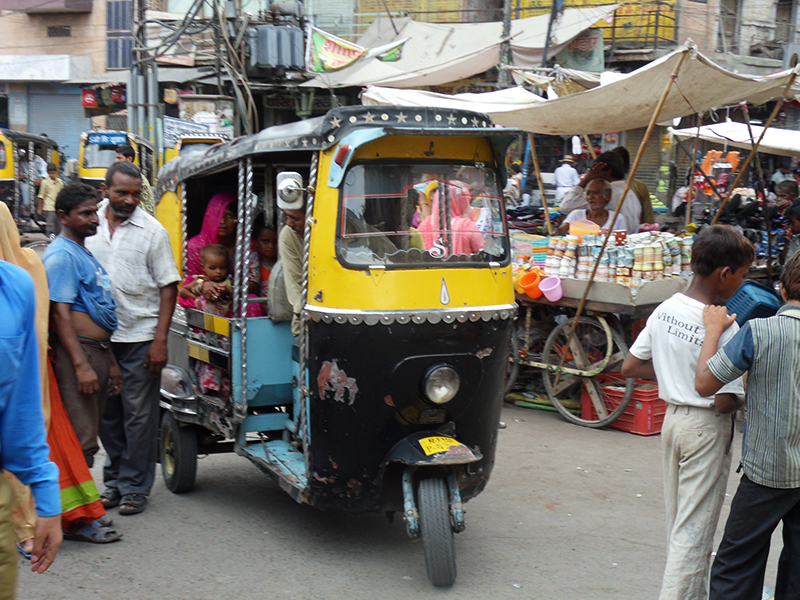 Later in the day, the area jumps to life. People and vehicles gum up the narrow, winding streets and the noise of commerce fills the air. We cannot take two steps without someone accosting us, imploring with sales diatribes that lean heavily on words like ‘cheap’ and ‘free look’, to visit their tiny establishments. Women in full sari, often bejeweled and sometimes carrying young children, float around the markets looking purposeful, making most of the purchases. It’s a real scrum as well as something of an assault course as we jink around rickshaws, people, cows, holes in the ground and the inevitable animal waste. But we entered into the swing and full spirit of the bustle with Debbie minutely examining several wonderfully worked shawls before making off with her bargain.
Later in the day, the area jumps to life. People and vehicles gum up the narrow, winding streets and the noise of commerce fills the air. We cannot take two steps without someone accosting us, imploring with sales diatribes that lean heavily on words like ‘cheap’ and ‘free look’, to visit their tiny establishments. Women in full sari, often bejeweled and sometimes carrying young children, float around the markets looking purposeful, making most of the purchases. It’s a real scrum as well as something of an assault course as we jink around rickshaws, people, cows, holes in the ground and the inevitable animal waste. But we entered into the swing and full spirit of the bustle with Debbie minutely examining several wonderfully worked shawls before making off with her bargain.
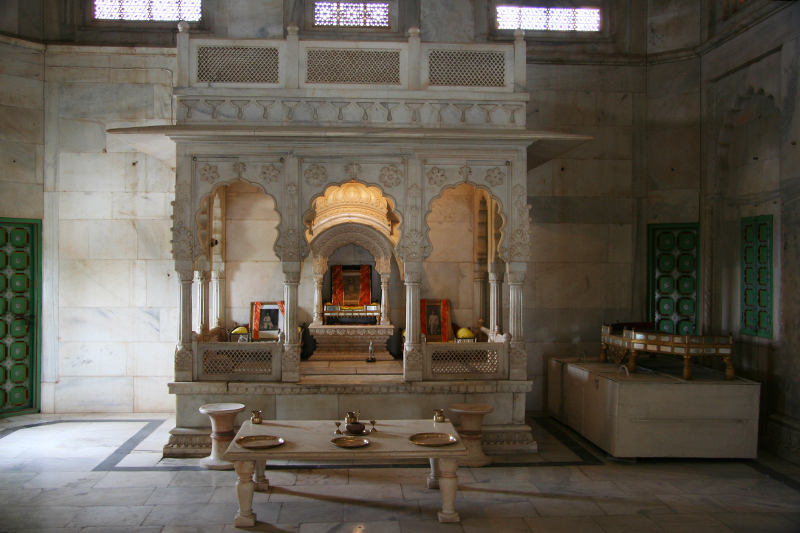 Retiring from the muddle and hubbub of the streets, we visited Jaswant Thada, a flamboyant, milky white marble crematorium of Maharaja Jaswant Singh II. It is still used as the last resting place and memorial to the current royals having photographs of the recently deceased. Some parts of the marble have become translucent, filling the internal hall with an eerie light.
Retiring from the muddle and hubbub of the streets, we visited Jaswant Thada, a flamboyant, milky white marble crematorium of Maharaja Jaswant Singh II. It is still used as the last resting place and memorial to the current royals having photographs of the recently deceased. Some parts of the marble have become translucent, filling the internal hall with an eerie light.
From there we stopped at the present day royal palace, a gigantic establishment that is so enormous that much of it has been turned into a luxury hotel without cramping the everyday life of the Maharaja. It is not a particularly wonderful building, the only interesting aspect being that it is mortarless; some of the larger stones having to be positioned using melting ice. The small area open to visitors has hundreds of photographs of the last Maharaja, a busy bee who founded the Jodhpur Polo Club and was keen on flying. There are a few glassed off rooms displaying dusty, silver furniture and, most disappointingly for me, a room full of clocks so basic in their operation and so dreadfully housed in (mostly) pewter, everyday objects (like trains, boats and lighthouses) that I left in a bit of a huff. For a lover of clocks, it was all too tasteless.
Hearing about the skill of the local craftsman in the villages outside Jodhpur, we hired a jeep to get out of town and visit local workshops. These small hamlets are dotted about in dry scrubland often with no road close by. They are difficult to find, especially as India seems to be devoid of maps, so we hired a guide named Kuldeep who was a part time lecturer at the local university.
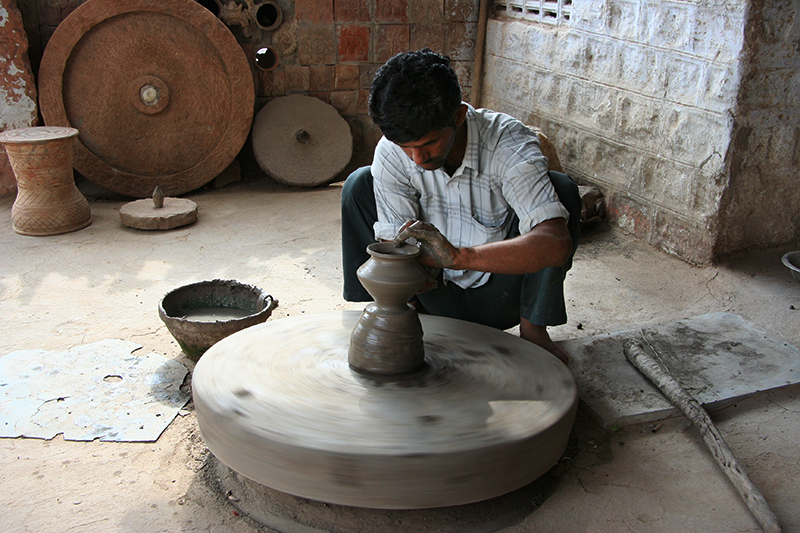 He took us to a Moailla or potter’s house where work had ceased during the monsoon season. The mud clay used to fashion household items does not dry properly in the wet atmosphere so the potter relies on stock built up in the dry months for income. The biggest demand is for water urns: The black clay is mixed with sawdust of ash before being dried in the sun and fired in the homemade kiln. The heat of the kiln burns the ash leaving hundreds of little holes, too small to see, in the pots. These help to keep the water cool during the heat of the day until, after about three months, the holes become blocked by residue from evaporated water and the urn is discarded. It’s a brilliant bit of built-in obsolescence ensuring continuous demand for the potter’s wares.
He took us to a Moailla or potter’s house where work had ceased during the monsoon season. The mud clay used to fashion household items does not dry properly in the wet atmosphere so the potter relies on stock built up in the dry months for income. The biggest demand is for water urns: The black clay is mixed with sawdust of ash before being dried in the sun and fired in the homemade kiln. The heat of the kiln burns the ash leaving hundreds of little holes, too small to see, in the pots. These help to keep the water cool during the heat of the day until, after about three months, the holes become blocked by residue from evaporated water and the urn is discarded. It’s a brilliant bit of built-in obsolescence ensuring continuous demand for the potter’s wares.
Our second stop was at the house of a cow herdsman in one of the Bishnoi villages. His home was handmade from layers of white painted clay that had a thatched roof constructed from layers of reed, leaf, and straw. He welcomed us with a cup of marsala chai and offered us the traditional drink of friendship – opium. We declined his kind offer but he, nonetheless, demonstrated the local art of making an opium drink from a tiny nugget of the drug. India is the second largest producer of opium and the largest exporter. The drug is crushed and diluted in water (not smoked) and filtered several times though sheep’s wool before being offered to guests who drink from the bare hand of the host.
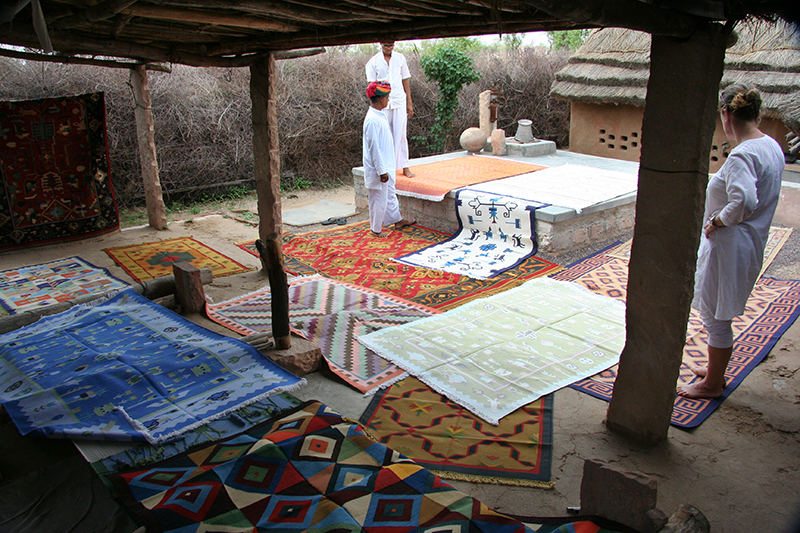 We left the herdsman in cuckoo land and stopped at the immaculately kept home of a local Prajapatti or weaver. This chap made carpets from cotton. He was successful enough to afford solar panels and was the head of a local cooperative of 50 people (15 families) that sold their products to interior design studios. His designs, known as Dhurris, took him and his workmate (they always work in two’s – one either side of the carpet) 10 days to create into a rug, in a process of interlock weaving. He spoke excellent English that he said he had learnt from tourists. From time to time this allowed him to take his cooperative’s floor coverings to exhibitions to sell and promote the craftsmanship of their products. Debbie was sufficiently taken that she bought one of the larger rugs (at a discount price naturally) and had it shipped home for the princely sum of “110 quid” as our weaver friend put it.
We left the herdsman in cuckoo land and stopped at the immaculately kept home of a local Prajapatti or weaver. This chap made carpets from cotton. He was successful enough to afford solar panels and was the head of a local cooperative of 50 people (15 families) that sold their products to interior design studios. His designs, known as Dhurris, took him and his workmate (they always work in two’s – one either side of the carpet) 10 days to create into a rug, in a process of interlock weaving. He spoke excellent English that he said he had learnt from tourists. From time to time this allowed him to take his cooperative’s floor coverings to exhibitions to sell and promote the craftsmanship of their products. Debbie was sufficiently taken that she bought one of the larger rugs (at a discount price naturally) and had it shipped home for the princely sum of “110 quid” as our weaver friend put it.
Having done our bit to kick start the local economy, it was time to move on. We still have much of Rajasthan to cover and it feels as if time is running out.

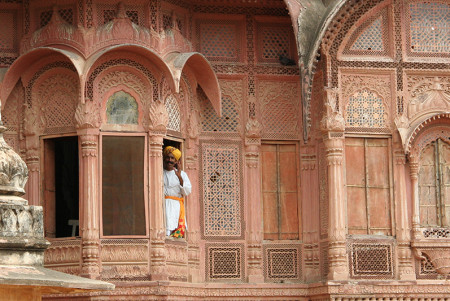
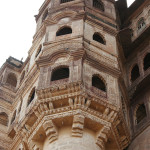
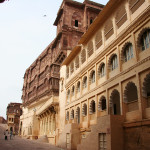
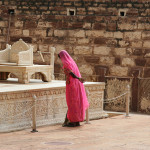
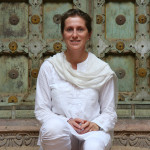
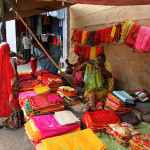
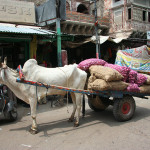
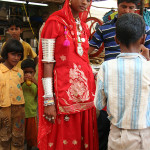
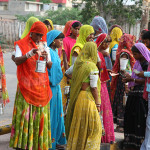
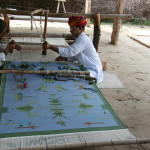
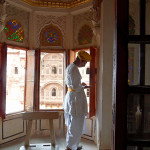
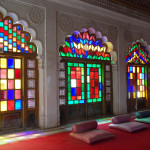
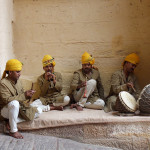
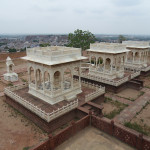
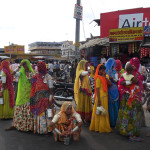
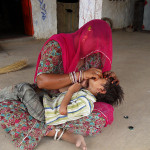

No comments yet.